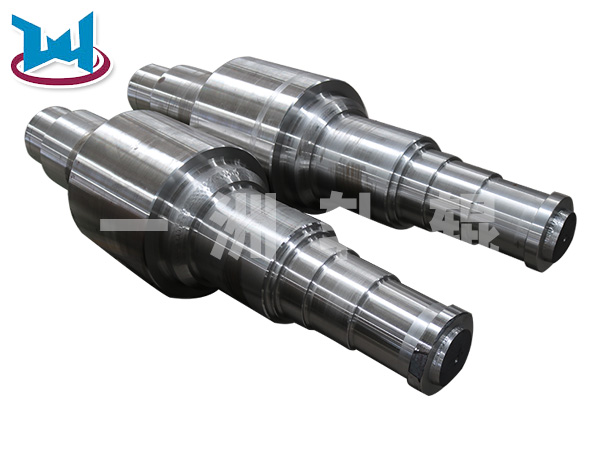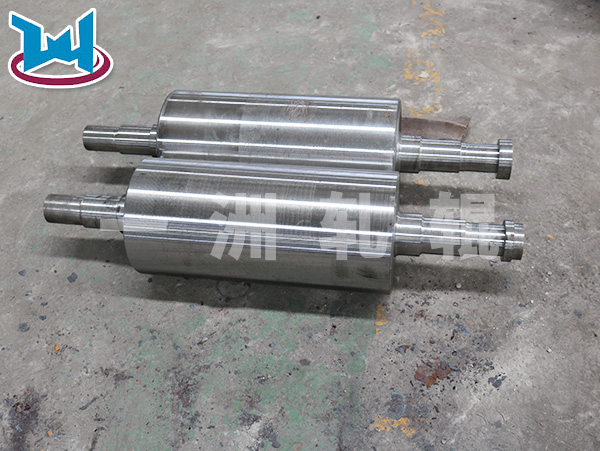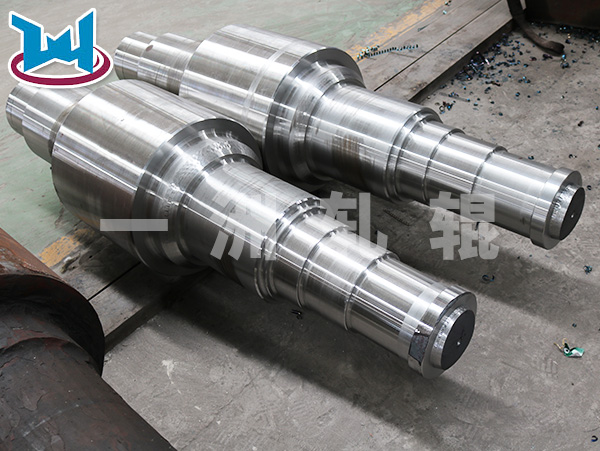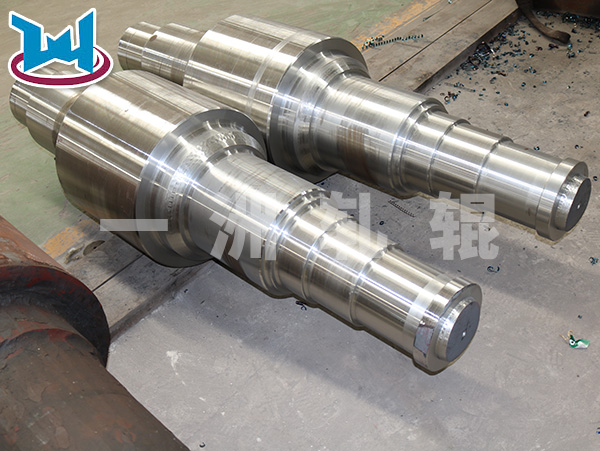Forged Steel Backup Roll

The essence of backup roll is to support the work roll. By contacting the work roll with the workpiece, the diameter of the work roll can be reduced and the stiffness of the work roll can be enhanced. Backup roll is an important part of rolling mill. It is used to support work roll or intermediate roll in order to prevent the work roll from deforming and affecting the output and quality of plate and strip. The quality characteristics of backup roll are high surface hardness, good uniformity of hardness, deep hardening layer, good strength and toughness of roll neck and roll body and mind; the quality characteristics of backup roll are high wear resistance, good peeling resistance and strong accident resistance.
The essence of backup roll is to support the work roll. By contacting the work roll with the workpiece, the diameter of the work roll can be reduced and the stiffness of the work roll can be enhanced. Backup roll is an important part of rolling mill. It is used to support work roll or intermediate roll in order to prevent the work roll from deforming and affecting the output and quality of plate and strip. The quality characteristics of backup roll are high surface hardness, good uniformity of hardness, deep hardening layer, good strength and toughness of roll neck and roll body and mind; the quality characteristics of backup roll are high wear resistance, good peeling resistance and strong accident resistance.
Product Details| Product Name | Hardness range | Quenching depth | Hardness uniformity |
| Back-up Roll | 60-80HSD | 10-75mm | +/-1.5 HSD |
Working conditions and performance requirements of backup rolls:
1. In the rolling process, the backup roll plays a supporting role on the working roll, which ensures that the working roll has high stiffness and small deformation. Therefore, the backup roll should have good stiffness.
2. In the process of using, the backup roll always contacts with the working roll or the intermediate roll, which is easy to produce work hardening phenomenon. When overloading, local yield causes subcutaneous microcracks at the bottom of the hardening layer, and microcrack propagation eventually results in roll spalling, which requires that the backup roll has high contact fatigue strength, reasonable stress state and stress state. Crack growth resistance.
3. The middle part of the backup roll will be concave because of wear and tear, and the contact stress at both ends of the roll body will increase sharply, which will lead to spalling. Therefore, good wear resistance of the roll is required to delay and alleviate the formation of the depressed roll profile.
4. The backup roll has a long service life and the neck of the roll bears alternating bending stress for a long time. In order to prevent the neck from cracking, it is required that the neck of the roll has good yield strength, toughness and fracture resistance.
In a word, the perfect combination of high wear resistance, high yield strength and spalling resistance of roll body with high strength, high toughness and fracture resistance of roll neck is the essential performance of backup roll.
Final heat treatment process of Large Forged Steel Backup roll:
The final heat treatment is an important link to make the backup roll meet the requirements. With the continuous improvement of the requirements for the backup roll, the final heat treatment process has changed from integral heating + quenching + tempering to surface quenching + tempering of the roll body. Surface hardening of roll body is particularly important in this process. It directly affects the hardness of roll body and the depth of hardened layer, and has a great impact on product performance.
The surface quenching process of roll body should be selected according to its comprehensive performance and user requirements. The advanced roll surface hardening technology for large forged steel backup rolls has two kinds: differential temperature quenching (differential heating + spray cooling) and induction hardening (integral induction heating + spray cooling). The biggest difference between the two processes is the different ways of quenching and heating. The similarity is that the surface of the forging is rapidly heated to the temperature above the transformation temperature while the core is kept below the phase transition temperature, and spray cooling is adopted. Spray cooling is made by mixing water and compressed air in a nozzle at a certain pressure and spraying into the roller to cool. The cooling intensity can be adjusted conveniently by adjusting the wind pressure and water pressure.
The roller body surface quenching uses the differential temperature quenching technology. After the semi-finished machining, the supporting roller blank qualified by ultrasonic testing is first preheated at 500~600 degrees in the car furnace, and the temperature inside and outside the roller body is uniform and uniform. Then the backup roll is transferred to the differential temperature furnace and the spray quenching equipment, and the differential heating and quenching treatment of the roller body are carried out. 。 Differential temperature heating furnace is characterized by fast heating speed, the surface temperature of backup roll can be raised from 500 to more than 1000 degrees in 1.5-2 hours, uniform heating, workpiece rotating 90 degrees every certain time in the furnace, and deep heating layer, backup roll holding in the furnace for about 4 hours, the depth of heating layer can reach about 200 mm. The advantage of surface quenching with differential temperature quenching technology is that when the surface of the roller reaches quenching temperature at a certain depth, the core is still below austenitizing temperature. After intense spray quenching, the core can be guaranteed to have a smaller tensile stress, thus improving the accident resistance of the backup roll.
Differential quenching process is an advanced and mature technology in the final heat treatment process of large forged steel backup rolls in China. The surface hardness of the backup roll body of large forged steel Cr3-Cr5 produced by differential temperature quenching process is 55-71 HSD, the depth of hardening layer is less than 100 mm, the hardness uniformity is (+2 HSD), the quenched structure is bainite, and the hardness and strength are good. It is suitable for the backup roll of forged steel required by the general hardness and the depth of hardening layer in steel works. However, it is difficult to produce high hardness backup rolls with martensite structure whose roll body hardness is more than 72HSD.
The whole body induction hardening process is used for roller body surface quenching. After the semi-finished machining, the backup roller body with ultrasonic flaw detection is fully inducted and heated, and then spray quenching, some new large-sized forged steel backup rolls production plants in China are expected to adopt this technology.
Integral induction hardening process has been applied in the manufacturing of large forged steel backup rolls abroad. It is the most advanced final heat treatment process in the world. It has been adopted by JCFC, Hitachi and Kanto. There is no such production process in our country. The backup roll of Baosteel 2050 hot rolling mill has tried out the large forged steel backup roll produced by JCFC company by integral induction quenching heat treatment process, and its application effect is very good. According to the experts concerned, the surface hardness of the roll body produced by integral induction hardening process for large forged steel backup rolls of Cr3-Cr5 steel is 60-80 HSD, the depth of hardening layer is more than 100 mm, the hardness uniformity is (+1.5 HSD), and the quenched structure is martensite or martensite+bainite.
Therefore, the first choice of final heat treatment process for Large Forged Steel Backup Roll should be integral induction hardening. The comprehensive performance of large forged steel backup roll produced by this process is better than that of products treated by differential temperature hardening. In order to narrow the gap with the foreign roll manufacturing industry, it is suggested that the roll manufacturer should cooperate closely with the relevant research institutes and colleges to speed up the research and development of the whole induction hardening treatment technology, and strive to fill this domestic gap in a short time, and apply it to the roll manufacturing as soon as possible. The reason why it is hoped that the final heat treatment of large forged steel backup rolls in China will choose the whole induction quenching process is based on the following reasons.
1. With the continuous improvement of plate shape requirements and the application of shape control technology CVC and HC, the martensite matrix structure and roll body hardness 72-78 HSD are required for cold rolling continuous annealing and hot galvanizing four-roll flat backup rolls, which can only be achieved by induction hardening treatment as a whole.
2. With the wide application of Semi-high-speed steel and high-speed steel in hot rolling mill working roll, the requirement of hardness and wear resistance of backup roll has been constantly improved, and it is difficult to meet the requirement by using differential temperature quenching process.
3. With the increasing market demand, the pressure of production cost is increasing. It requires that the roll change cycle of backup roll be synchronized with the maintenance cycle, and the roll change cycle be longer. It requires that the wear resistance and accident resistance of the surface of backup roll be better, and the whole induction quenching process is more suitable.
4. Integral induction hardening is the most advanced in the final heat treatment process. It will produce first-class Forged Steel Backup rolls, which will greatly improve the wear resistance, fracture toughness and fatigue spalling resistance of forged steel backup rolls and narrow the gap with foreign countries.
5. The implementation of the whole induction quenching heat treatment process can fill another gap in the domestic roll body surface quenching process, which is the first in China and the world's advanced level.





 Focus on us
Focus on us